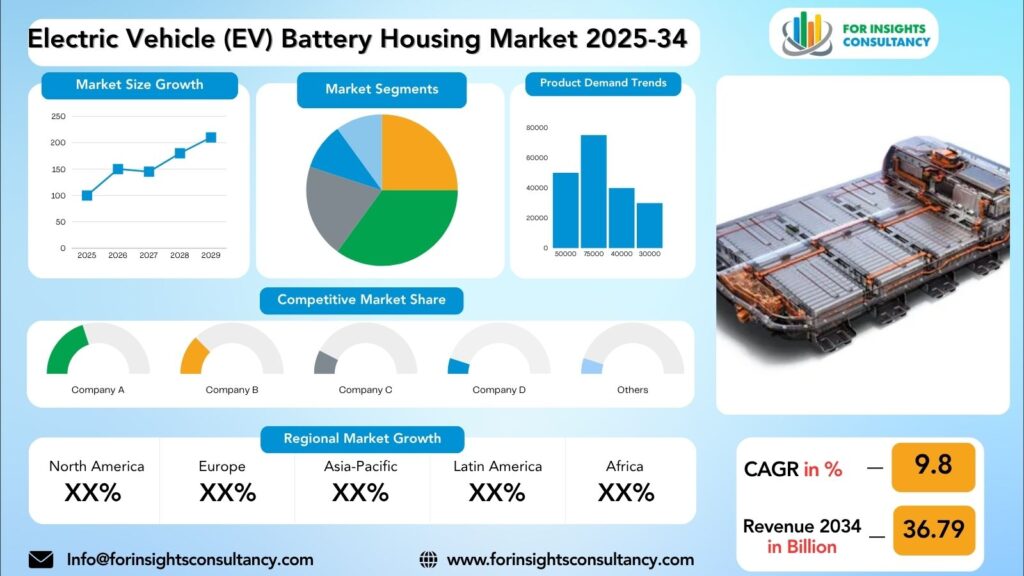
Electric Vehicle (EV) Battery Housing Market Size, Trends Analysis Research Report by Material (Aluminum, Steel, Carbon Fiber Reinforced Plastic (CFRP), Glass Fiber Reinforced Plastic (GFRP), Composite Materials), by Vehicle Type (Passenger Cars, Light Commercial Vehicles (LCVs), Heavy Commercial Vehicles (HCVs)), by Propulsion Type, and By Region Global Market Analysis And Forecast, 2025-2034
Oct-2025 Formats | PDF | Category: Automotive | Delivery: 24 to 72 Hours
Global revenue from the Electric Vehicle (EV) Battery Housing market is valued at US$ 17.64 Billion in 2025 and has been probable to increase at a CAGR of 9.8% to reach US$ 36.79 billion by the end of 2034.
Electric Vehicle (EV) Battery Housing Market: A Comprehensive Overview and Future Developments
The Electric Vehicle (EV) Battery Housing Market stands to significantly grow in the next few years as the sustainable transportation trend is being adopted worldwide. In such a case, the in-depth image will reflect different facets of the Electric Vehicle (EV) Battery Housing market, such as prevailing trends, issues, and upcoming innovations.
The market for EV battery housing is a fast-growing one due to the mass adoption of electric vehicles, clean-energy-promoting government initiatives, and the technological advancements in battery. As a consequence of the fierce competition, a handful of these major players in the industry are dedicating considerable resources to research and development to upgrade both the performance and the life of the battery housings.
The future of the EV battery housing market is bright thanks to such improvements as the use of lighter materials, heat control systems, and modular structures for better performance and safety. They are designed to address issues such as range anxiety, limited charging infrastructure, and high prices.
To sum up, the EV battery housing market will be undergoing swift changes, thus offering a great number of possibilities to those who want to invest in the industry. Make sure to catch the latest changes in this vibrant market sector.
Market Insights
The Electric Vehicle (EV) Battery Housing Market is expected to show a notable rise in 2024. Asia-Pacific is likely to be a major contributor to this regional revenue share, primarily due to the widespread adoption of electric vehicles in China and Japan.
There is a strong possibility of this region’s growth surpassing other areas because of clean government policies and a rising demand for electric vehicles (EVs).
America with nearly 80% of its population living in urban areas, is predicted to be a major source of demand for electric vehicles and their parts, i.e., battery housings.
Passenger electric vehicles are expected to account for the largest share of the segments revenues as the consumers eco-friendliness and green-consciousness progressively become their transportation criteria.
In general, 2024 promises a breakthrough year for the EV Battery Housing Market, with heavy growth and innovation in the Asia-Pacific region as well as in the U.S. urban markets.
Market Dynamics
Trends
- Increasing Demand for Lightweight Materials: As the primary focus is on energy efficiency and range of electric vehicles, car manufacturers are turning to lightweight materials such as aluminum and carbon fiber for battery housing.
- Growth of Modular Battery Designs: The concept of modular battery designs is very much talked about in the EV industry, as it allows flexibility in terms of storage capacity and scalability. The trend is expected to be around for the next few years.
- Advancements in Thermal Management Systems: Enhanced thermal management systems are being introduced to keep the EV battery housings at optimal temperatures. This is one of the ways to improve battery performance and increase its lifespan.
- Integration of Smart Technologies: It is expected that the implementation of intelligent technologies such as sensors and connectivity features in the battery boxes of EVs will facilitate the battery condition and performance check in real-time.
- Emphasis on Sustainable Materials: The move towards sustainability is the main reason behind the deployment of environmentally friendly materials in the battery housings of EVs which is in line with the industry’s commitment to environmental sustainability.
Growth Drivers
- As a result of increasing concerns for the environment and various government subsidies promoting the use of clean transportation, electric vehicles are being more and more widely adopted all over the world.
- Battery performance, efficiency, and cost-effectiveness are all being improved as a result of the technological advancements, thus making the electric vehicle an increasingly attractive option for the consumers.
- A network of charging stations is being set up to help alleviate range anxiety and make the use of electric vehicles more convenient.
- There is a growing focus on energy density, safety, and lifespan of lithium-ion batteries in electric vehicles as evidenced by a rise in investments in research and development of next-generation battery technologies.
- Transition to sustainable and eco-friendly modes of transport is the main reason behind the increasing demand for electric vehicles and the components such as battery housings, which are expected to rise in the next couple of years.
Restraints
- Fluctuations in the prices of raw materials could affect the costs of manufacturing battery housings for electric vehicles (EVs).
- Tight regulations and standards concerning the recycling and disposal of EV batteries may result in increased operational costs for market players.
- The limited supply of rare earth metals and minerals that are necessary for battery production could become a bottleneck for the scaling of the production of EV battery housings.
- The fierce competition in the market may result in the lowering of prices and the reduction of profit margins of manufacturers.
- The issues of cooling and thermal management inefficiencies in EV batteries may limit the implementation of advanced solutions in battery housings.
- These constraints are important considerations for the stakeholders of the Electric Vehicle (EV) Battery Housing Market in the next years.
Opportunities
- The market is set to expand largely due to the increasing demand for electric vehicles (EVs).
- Governments worldwide, through various initiatives and incentives, are pushing the adoption of EVs.
- Advancements in technology are the main reason behind the more efficient and smaller battery housings.
- One of the major drivers behind the electric vehicle market is the crisis of the environment and the need for sustainable solutions.
- The growth of the EV market will be supported by the charging infrastructure that is being expanded.
- The integration of renewable energy sources to charge EV batteries is opening up new opportunities for battery housing manufacturers.
- The collaboration between automakers and battery housing suppliers can improve product offerings and extend market reach.
- Battery housing designs may have the potential for customization and innovation to satisfy different consumer preferences and vehicle requirements.
Challenges
- Supply Chain Disruptions: The manufacturers of EV battery housings may encounter difficulties in maintaining a reliable supply chain for raw materials as a result of worldwide disruptions and shortages.
- Cost Management: As the trend towards EVs continues to rise, producers will have to prioritize cost management to be able to offer battery housings at a competitive price while still maintaining the quality.
- Regulatory Compliance: One of the biggest challenges of the companies operating in the market will be to conform to strict environmental regulations and safety standards related to EV battery housings.
- Technological Advancements: It will be very important for market players to be able to keep up with the fast technological changes in battery materials and energy storage device designs in order to be able to improve performance and increase energy storage capabilities.
- Competition: The competition in the EV battery housing market will become more and more intense due to the increasing number of players that are entering the market, thus it will be difficult to retain market share and come up with strategies for differentiation.
Electric Vehicle (EV) Battery Housing Market Top Companies Covered In This Report:
Evaluate The Strategic Positioning And Innovation Pipelines Of Leading Market Companies-From Multinational Enterprises To Disruptive Regional Firms. Understand How Key Players Are Innovating, Expanding, And Capturing Value, And Use Competitive Benchmarks To Plan Your Next Move.
- LANXESS
- Evonik Industries AG
- Covestro AG
- Gestamp Automocion, S.A.
- Constellium SE
- SGL Carbon
- Nemak, S.A.B. de C.V.
- Novelis Inc
- Hanwha Solutions Advanced Materials
- UACJ Corporation
- GF Linamar LLC
- ThyssenKrupp AG
- Minth Group
- Magna International Inc.
- TRB Lightweight
- Hitachi Metals, Ltd.
- Norsk Hydro ASA
- Kautex Textron GmbH & Co. KG
- Saudi Basic Industries Corporation
- Teijin Limited
Electric Vehicle (EV) Battery Housing Market Company News 2024 and 2025
SGL Carbon
On December 30, 2024, Nemak announced a strategic adjustment to one of its EV battery-housing production projects: downsizing the contracted capacity and postponing the launch of new manufacturing facilities in Mexico and Germany.
In April 2025, Nemak signed a Letter of Intent (LOI) with Hydro Aluminium to develop low-carbon aluminium casting solutions for the automotive industry, reflecting a pivot toward sustainable supply chains.
LANXESS AG
In September 2024, LANXESS received the ICIS Innovation Award for its breakthrough in iron-oxide materials used in LFP (lithium-iron-phosphate) battery cathodes, highlighting its growing role in the broader EV battery ecosystem (though not strictly for housings).
Novelis Inc.
On March 12, 2025, Novelis announced a collaboration with Shape Corp. and Metalsa to develop aluminium-intensive EV battery enclosure solutions, targeting lighter weight, better performance and quicker go-to-market readiness.
Evonik Industries AG
On January 8, 2025, Evonik issued a €500 million green bond to fund ‘Next Generation Solutions’, including aluminium-oxide battery materials for e-mobility, underlining its strategic investment in the EV space.
On June 13, 2024, Evonik expanded its TEGO® Therm product range to include fire-resistant coatings for EV battery housings and covers, offering improved thermal insulation and fire-safety performance for lithium-ion batteries.
Segmented View of The Industry:
The Electric Vehicle (EV) Battery Housing Market Is Mapped Through A Multidimensional Lens-Tracking Shifts Across Product Type, Applications, And Geographic Regions. This Segmented Approach Enables Businesses to Localize Their Growth Plans And Align Offerings With The Most Profitable Demand Centres.
Segmentation By Material
- Aluminum
- Steel
- Carbon Fiber Reinforced Plastic (CFRP)
- Glass Fiber Reinforced Plastic (GFRP)
- Composite Materials
Segmentation By Propulsion Type
- Battery Electric Vehicles (BEV)
- Plug-in Hybrid Electric Vehicles (PHEV)
- Hybrid Electric Vehicles (HEV)
Segmentation By Vehicle Type
- Passenger Cars
- Light Commercial Vehicles (LCVs)
- Heavy Commercial Vehicles (HCVs)
Segmentation By Component
- Top Cover
- Bottom Cover
- Tray
- Cell Module
- Others
Segmentation By Manufacturing Process
- Stamping
- Casting
- Extrusion
- Injection Molding
Global Geographic Coverage:
The Report Provides In-Depth Qualitative And Quantitative Data On The Electric Vehicle (EV) Battery Housing Market For All Of The Regions And Countries Listed Below:
North America
The North American Electric Vehicle (EV) Battery Housing Market is expected to grow significantly, which is majorly influenced by a steady GDP growth rate of 2.5% and a low inflation rate of 1.8%. In the United States, the most notable factor that influences the market is the federal tax credit for EV purchases, which effectively encourages consumers to go for electric vehicles.
Whereas the primary channel for EV battery housing in North America is through specialized retailers and dealerships, the fastest-growing channel is online sales platforms because of the increased consumer demand for convenience. Sustainability and ethical sourcing are two factors that consumers in North America cannot do without as being eco-conscious and socially responsible has become a major determinant of purchasing decisions.
In contrast, in many emerging markets where price and status are the main considerations, consumers are more likely to prioritize affordability and brand reputation rather than sustainability and localism when deciding on EV battery housing.
Europe
The Electric Vehicle (EV) Battery Housing Market in Europe is expected to be largely influenced by the region’s increasing GDP and moderately stable inflation rates. In Germany, the single, unique, and non-replicable local factor after which the market is influenced is the government’s generous EV subsidy program that incentivizes consumers to adopt electric vehicles. In this market, the dominant channel for EV battery housing is through specialized electric vehicle dealerships, while the fastest-growing channel is online sales platforms. Buyers of such components in Europe progressively become more sustainability-conscious and demand the observance of ethical principles and localism in the production of EV battery housing. Yet, in numerous emerging markets where price and status are the main factors, these values are mostly considered as secondary ones by consumers.
Asia Pacific
The Electric Vehicle (EV) Battery Housing Market in the Asia Pacific region is expected to become very vibrant due to the skyrocketing demand for electric vehicles. The region’s anticipated GDP growth of 5% and inflation rate of 2% will be the main factors to push the market forward.
One of the most important things that the Chinese government is doing to stimulate the electric vehicle development is the provision of generous subsidies and incentives. It is the Original Equipment Manufacturers (OEMs) that are the main channel for EV battery housing, whereas the specialized EV battery housing suppliers are the fastest-growing channel.
Consumers in several emerging markets sometimes choose cheap products and brands that give them status over such things as sustainability or ethical sourcing. Nevertheless, localism is turning into a necessary attribute for consumers in countries like Japan and South Korea, where the support of local industries is getting more and more appreciated.
Middle East and Africa
The Electric Vehicle Battery Housing Market in the Middle East and Africa region is anticipated to grow significantly, largely due to the area’s 5-year GDP growth rate projection of 3.5% and inflation rate of 2.5%. For instance, in Egypt, the most distinctive local driver that influences the market is the government subsidy on EV purchases, which offers substantial incentives to consumers for the adoption of electric vehicles.
Most of the EV battery housing in the region is being channeled through governments’ programs and partnerships with automotive manufacturers. Meanwhile, the direct-to-consumer online sales channel is the quickest expanding channel, which is oriented to tech-savvy consumers who seek convenient purchasing options.
Consumers in the region are putting more and more emphasis on sustainability and ethical sourcing, thus these factors have become their purchasing decision criteria. In developing markets where price and status are the main factors, manufacturers must combine affordability with eco-friendly and socially responsible practices if they want to gain market share and increase their business.
Frequently Asking Questions
What is the Electric Vehicle (EV) Battery Housing market size and growth forecast?
Electric Vehicle (EV) Battery Housing Market is predicted to grow from USD 17.64 Billion in 2025 to approximately USD 36.79 Billion by 2034. the industry is estimated to expand at a CAGR of 9.8%.
Who are the key players in the Electric Vehicle (EV) Battery Housing market?
The Electric Vehicle (EV) Battery Housing Market Includes Major Companies LANXESS, Evonik Industries AG, Covestro AG, Gestamp Automocion, S.A., Constellium SE, SGL Carbon, Nemak, S.A.B. de C.V., Novelis Inc, Hanwha Solutions Advanced Materials, UACJ Corporation, GF Linamar LLC, ThyssenKrupp AG, Minth Group, Magna International Inc., TRB Lightweight, Hitachi Metals, Ltd., Norsk Hydro ASA, Kautex Textron GmbH & Co. KG, Saudi Basic Industries Corporation, Teijin Limited, Others.
What are the current and future trends for Electric Vehicle (EV) Battery Housing market?
The current trend in the EV Battery Housing Market is the adoption of lightweight materials and modular designs to improve vehicle range and thermal safety.
The future trend is the integration of advanced cooling and structural systems within housings, aligned with the shift to next-gen batteries and higher EV penetration.
What are the challenges facing the Electric Vehicle (EV) Battery Housing market?
The EV Battery Housing market faces challenges from high material and production costs, complex design requirements, and stringent safety standards. Additionally, limited recycling infrastructure and supply chain disruptions for lightweight materials hinder large-scale adoption.
Report Features
This report gives the most complete information. The report on Electric Vehicle (EV) Battery Housing Market format has been designed so that it can provide the best value to the business. It offers crucial insights into the market’s dynamic and will aid in strategic decision-making for current players as well as those looking to join the market.
What
Deliverables Will You Get in this Report?
|
Key
questions this report answers |
Relevant
contents in the report |
|
How big
is the sales opportunity? |
In-depth
analysis of the Global Electric Vehicle (EV) Battery Housing Market |
|
How
lucrative is the future? |
Market
forecast and trend data and emerging trends |
|
Which
regions offer the best sales opportunities? |
Global,
regional and country level historical data and forecasts |
|
Which are
the most attractive Electric Vehicle (EV) Battery Housing market Key
segments? |
Market
segment analysis and |
|
Which are
the top Key players and Their Electric Vehicle (EV) Battery Housing market
positioning? |
Competitive
landscape analysis, Market share analysis |
|
How
complex is the business environment? |
Porter’s
five forces analysis, PEST analysis, Life cycle analysis |
|
What are
the factors affecting the Electric Vehicle (EV) Battery Housing market? |
Drivers
& Restraints |
|
Will I
get the information on my |
Customized
Report as per your Business Needs Our
analysts will work directly with you and understand your needs Get data
on specified regions or segments, competitor and Vendors Data will
be formatted and presented as per your requirements Any
Requirement Contact Us: Https://Www.Forinsightsconsultancy.Com/Contact-Us |
Table of Contents
For TOC Contact us: https://forinsightsconsultancy.com/contact-us/






